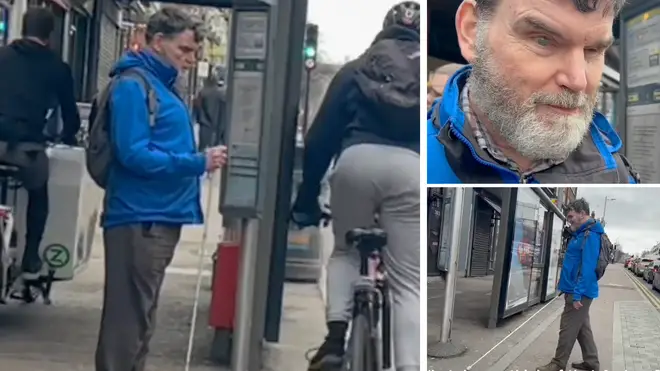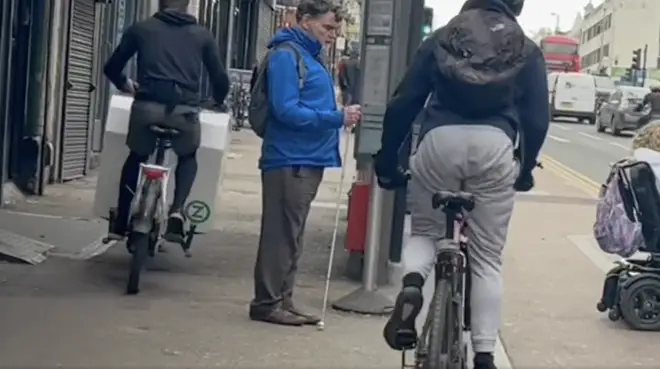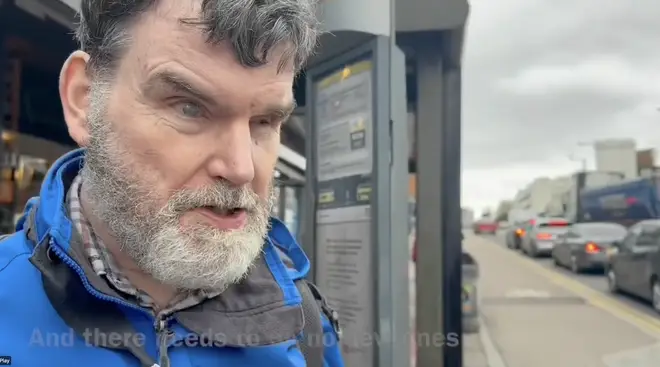
Nick Abbot 10pm - 1am
8 April 2023, 14:05 | Updated: 8 April 2023, 15:23

A hair-raising video shows the moment two cyclists weave past a woman in a wheelchair and a blind man holding a white stick, at a London 'floating' bus stop.
The video shows how the cyclists, going down a path through a "floating" bus stop between the road and the shelter, pass very close to the two disabled people.
One of the cyclists, a delivery rider, goes onto the pavement instead of slowing down or stopping for the people waiting for the bus.
The video, published by the National Federation of the Blind UK (NFBUK), also shows several other near-misses at the bus stop in Lea Bridge, in the north-east London borough of Waltham Forest.
One segment shows another cyclist on a cargo bike going down the bike lane at speed while a wheelchair user is trying to get on the bus.
This is what our President who is blind said about the bus stop design where you step off the bus onto a narrow bus boarder next to a cycle lane on Lea Bridge Road, Waltham Forest
— NFBUK (@NFBUK) April 3, 2023
‘Not fit for purpose. It really is totally inaccessible. These sorts of designs should be scrapped’ pic.twitter.com/e64hVexqea
NFBUK chief Andrew Hodgson is the blind man at the start of the video. He only became aware of the near-collision with the cyclists when a colleague told him what had happened afterwards.
He said: "It really is totally inaccessible. These sorts of designs need to be scrapped, those that have been installed need to be taken out and there need to be no new ones."
Mr Hodgson urged cyclists to be more careful around vulnerable pedestrians, adding that he could easily have been "mown down".
The Highway Code says that cyclists should give way to pedestrians on shared use cycle tracks," adding that they "should always take care when passing pedestrians, especially children, older or disabled people, and allow them plenty of room."

It adds that cyclists should "always be prepared to slow down and stop if necessary".
Floating bus stops, known officially as 'shared-use bus boarders' by Transport for London (TfL) have become more prevalent in recent years across the capital, as officials try to prioritise 'active travel' like cycling, while not compromising on public transport.
Transport chiefs say that floating bus stops are good for preventing cyclists from going out into traffic around buses, which could endanger them and drivers.
But the floating stops have been criticised by disability campaigners, who claim that many disabled and blind people they act as a hindrance to getting on buses.

An independent review is expected this year, and mayor Sadiq Khan, who has refused to pause the roll-out in the mean time, has said he is looking forward to reading it.
Helen Cansick, TfL's Head of Healthy Streets Investment, said: 'Keeping everyone travelling in the capital safe is our top priority and the needs of blind and partially sighted people are always taken into consideration when designing cycle lanes.
"Bus stop bypasses and shared use bus borders are a nationally recognised approach for avoiding the dangers of cyclists going around buses into oncoming traffic.
"TfL and the London Boroughs, like many cities across the country, have integrated this approach into the cycleway programme and there has been a dramatic increase in number of people cycling in the city.
"We have met with the NFBUK to discuss this, and other such facilities, and are conducting a review of safety at these facilities.
"We welcome all feedback on our cycle routes and will continue to work with disabled people and accessibility groups, taking people’s concerns into account to ensure that changes to our roads work for everyone.'